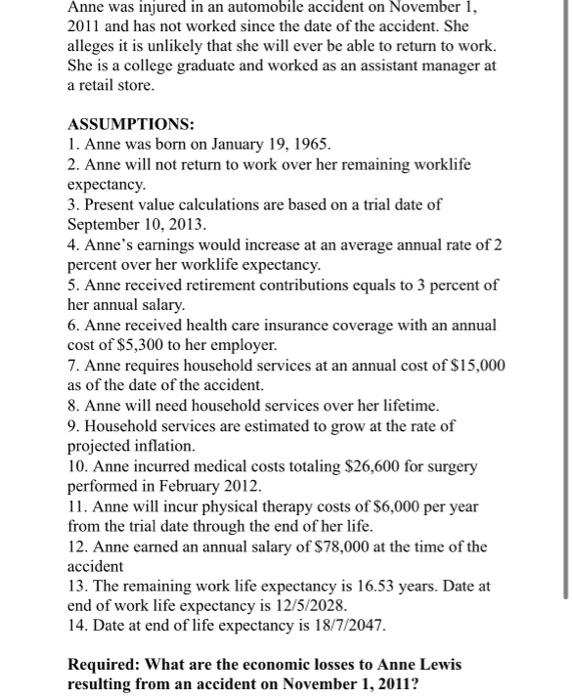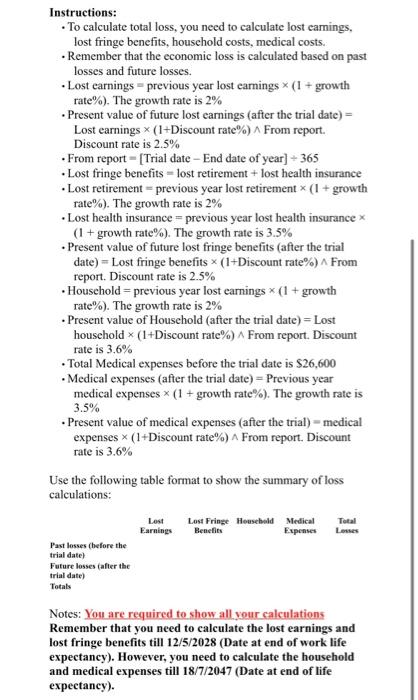Anne was injured in an automobile accident on November 1, 2011 and has not worked since the date of the accident. She alleges it is unlikely that she will ever be able to return to work. She is a college graduate and worked as an assistant manager at a retail store. ASSUMPTIONS: 1. Anne was born on January 19, 1965. 2. Anne will not return to work over her remaining worklife expectancy. 3. Present value calculations are based on a trial date of September 10, 2013. 4. Anne's earnings would increase at an average annual rate of 2 percent over her worklife expectancy. 5. Anne received retirement contributions equals to 3 percent of her annual salary. 6. Anne received health care insurance coverage with an annual cost of $5,300 to her employer. 7. Anne requires household services at an annual cost of $15,000 as of the date of the accident. 8. Anne will need household services over her lifetime. 9. Household services are estimated to grow at the rate of projected inflation. 10. Anne incurred medical costs totaling $26,600 for surgery performed in February 2012. 11. Anne will incur physical therapy costs of $6,000 per year from the trial date through the end of her life. 12. Anne earned an annual salary of $78,000 at the time of the accident 13. The remaining work life expectancy is 16.53 years. Date at end of work life expectancy is 12/5/2028. 14. Date at end of life expectancy is 18/7/2047. Required: What are the economic losses to Anne Lewis resulting from an accident on November 1, 2011? Instructions: To calculate total loss, you need to calculate lost camings, lost fringe benefits, household costs, medical costs. . Remember that the economic loss is calculated based on past losses and future losses. - Lost earnings previous year lost earnings (1 + growth rate%). The growth rate is 2% Present value of future lost earnings (after the trial date) = Lost earnings * (I+Discount rate%) From report. Discount rate is 2.5% From report - [Trial date - End date of year] + 365 Lost fringe benefits - lost retirement + lost health insurance Lost retirement previous year lost retirement (1 + growth rate%). The growth rate is 2% Lost health insurance = previous year lost health insurance (1 + growth rate%). The growth rate is 3.5% Present value of future lost fringe benefits (after the trial date) Lost fringe benefits X (1+Discount rate%) From report. Discount rate is 2.5% Household = previous year lost earnings *(1 + growth rate%). The growth rate is 2% Present value of Household (after the trial date) = Lost household (1+Discount rate%) From report. Discount rate is 3.6% Total Medical expenses before the trial date is $26,600 Medical expenses (after the trial date) = Previous year medical expenses x (1 + growth rate%). The growth rate is 3.5% Present value of medical expenses (after the trial)-medical expenses (1+Discount rate%) From report. Discount rate is 3.6% Use the following table format to show the summary of loss calculations: Lest Lost Fringe Household Medical Total Earnings Benefits Expenses Past losses (before the trial date) Future losses (after the trial date) Totals Losses Notes: You are required to show all your calculations Remember that you need to calculate the lost earnings and lost fringe benefits till 12/5/2028 (Date at end of work life expectancy). However, you need to calculate the household and medical expenses till 18/7/2047 (Date at end of life expectancy). Anne was injured in an automobile accident on November 1, 2011 and has not worked since the date of the accident. She alleges it is unlikely that she will ever be able to return to work. She is a college graduate and worked as an assistant manager at a retail store. ASSUMPTIONS: 1. Anne was born on January 19, 1965. 2. Anne will not return to work over her remaining worklife expectancy. 3. Present value calculations are based on a trial date of September 10, 2013. 4. Anne's earnings would increase at an average annual rate of 2 percent over her worklife expectancy. 5. Anne received retirement contributions equals to 3 percent of her annual salary. 6. Anne received health care insurance coverage with an annual cost of $5,300 to her employer. 7. Anne requires household services at an annual cost of $15,000 as of the date of the accident. 8. Anne will need household services over her lifetime. 9. Household services are estimated to grow at the rate of projected inflation. 10. Anne incurred medical costs totaling $26,600 for surgery performed in February 2012. 11. Anne will incur physical therapy costs of $6,000 per year from the trial date through the end of her life. 12. Anne earned an annual salary of $78,000 at the time of the accident 13. The remaining work life expectancy is 16.53 years. Date at end of work life expectancy is 12/5/2028. 14. Date at end of life expectancy is 18/7/2047. Required: What are the economic losses to Anne Lewis resulting from an accident on November 1, 2011? Instructions: To calculate total loss, you need to calculate lost camings, lost fringe benefits, household costs, medical costs. . Remember that the economic loss is calculated based on past losses and future losses. - Lost earnings previous year lost earnings (1 + growth rate%). The growth rate is 2% Present value of future lost earnings (after the trial date) = Lost earnings * (I+Discount rate%) From report. Discount rate is 2.5% From report - [Trial date - End date of year] + 365 Lost fringe benefits - lost retirement + lost health insurance Lost retirement previous year lost retirement (1 + growth rate%). The growth rate is 2% Lost health insurance = previous year lost health insurance (1 + growth rate%). The growth rate is 3.5% Present value of future lost fringe benefits (after the trial date) Lost fringe benefits X (1+Discount rate%) From report. Discount rate is 2.5% Household = previous year lost earnings *(1 + growth rate%). The growth rate is 2% Present value of Household (after the trial date) = Lost household (1+Discount rate%) From report. Discount rate is 3.6% Total Medical expenses before the trial date is $26,600 Medical expenses (after the trial date) = Previous year medical expenses x (1 + growth rate%). The growth rate is 3.5% Present value of medical expenses (after the trial)-medical expenses (1+Discount rate%) From report. Discount rate is 3.6% Use the following table format to show the summary of loss calculations: Lest Lost Fringe Household Medical Total Earnings Benefits Expenses Past losses (before the trial date) Future losses (after the trial date) Totals Losses Notes: You are required to show all your calculations Remember that you need to calculate the lost earnings and lost fringe benefits till 12/5/2028 (Date at end of work life expectancy). However, you need to calculate the household and medical expenses till 18/7/2047 (Date at end of life expectancy)








